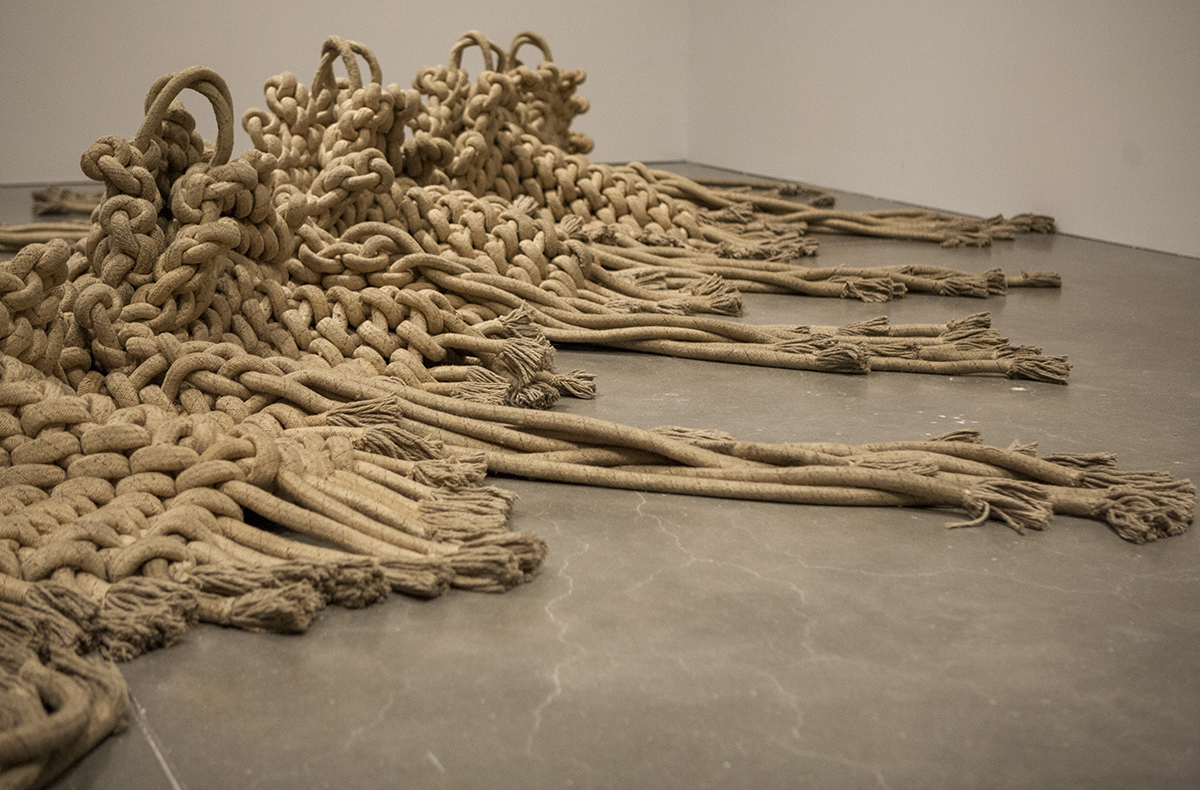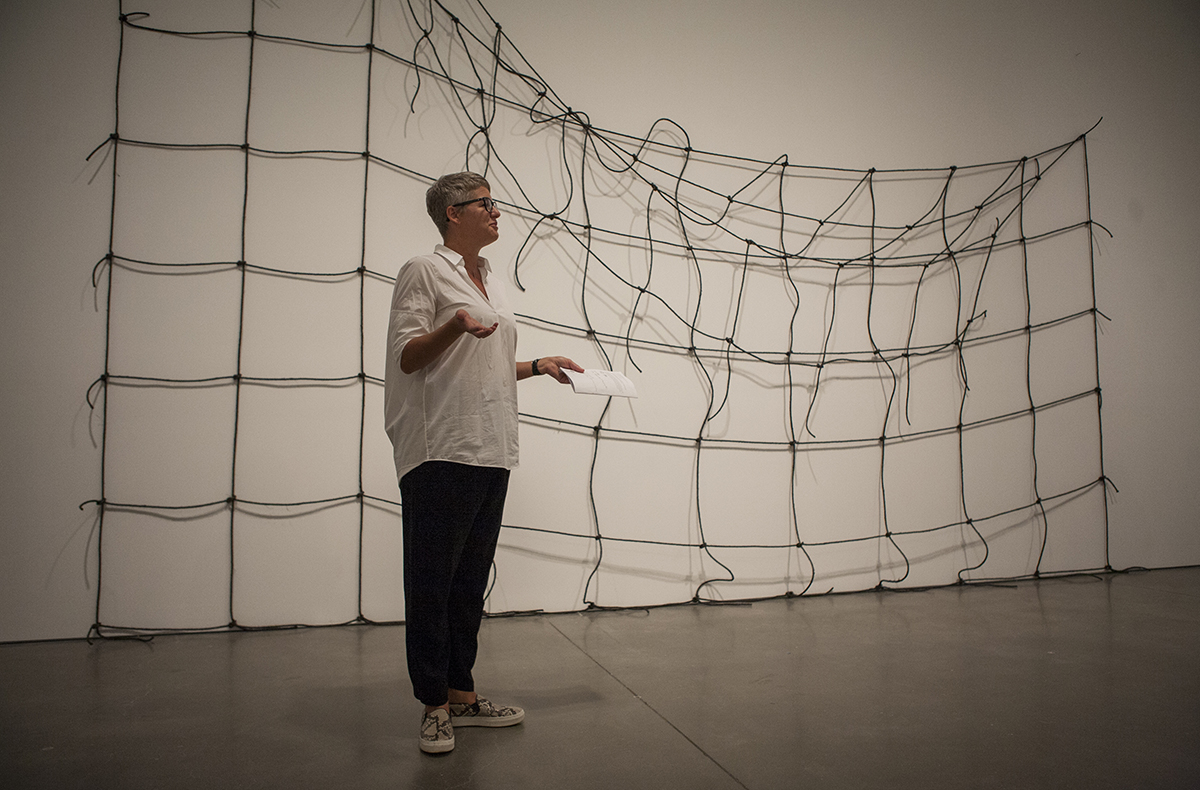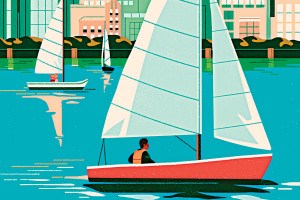ICA Curator Uncovers Key Works of Fiber Art in New Exhibit

Paris-based artist Sheila Hicks created her installation “Pillar of Inquiry/Supple Column” from linen, cotton, bamboo, and silk. Hicks is one of the artists featured in the ICA’s new exhibit “Fiber Sculpture: 1960-Present.” / Photo by Olga Khvan
With about 50 years’ worth of experience in creating fiber art, Sheila Hicks is behind both one of the earliest pieces in the ICA’s exhibition “Fiber Sculpture: 1960-Present” and the most recent.
On Tuesday morning, the Paris-based artist attended a press preview of the new exhibition, which opens to the public Wednesday, rearranging her 1965-1966 wool-and-linen piece titled “Banisteriopsis II” and pulling on the individual threads of her 2013-2014 installation titled “Pillar of Inquiry/Supple Column,” created from linen, cotton, bamboo, and silk.
ICA curator Jenelle Porter, who has been working on the show for the past four years—up until 10:30 p.m. the night before the press preview—joked about Hicks’s “irresponsible handling” of the pieces, as the artist encouraged the press to touch and feel the materials despite the standard no-touching policy enforced at the museum. Jokes aside, Porter also praised Hicks and the other 32 international artists featured in the exhibition for their sustained dedication to working with fiber.
“For me, that was one of the guiding principles of the show. I didn’t want an artist who—and I could name a handful—kind of dabbled with the material to use it just to express conceptual ideas,” she said. “I was interested in showing that artists like Françoise Grossen and Sheila Hicks and others have been working with this material for years to understand different ways of working it, and all these different forms it can take, and all these different kinds of materials and what they can do, from the most natural and ancient of fibers like linen to the highest technology that exists for materials at any certain point.”
“Fiber Sculpture: 1960-Present” is the first major exhibition on fiber art in 40 years, and during her research, Porter pored over catalogs from previous major exhibitions, such as the International Tapestry Biennials held over 30 years in Lausanne, the 1969 “Wall Hangings” show at the Museum of Modern Art, and the 1969 “Anti-Illusion: Procedures/Materials” show at the Whiney Museum of American Art. She discovered key works of fiber art, some of them new even to her, driven by an interest in artists with a strong dedication for experimenting with the material and a rebellious streak of freeing their art from the walls, allowing it to rise up into the air or sink down to the floor.
“I think with textiles and soft materials, it was kind of like the last taboo—taking something soft that could absorb dirt and putting it on the floor was kind of very radical,” Porter said. “Sometimes I think that fiber’s softness is closest to the way our bodies are. We succumb to gravity. It’s a very human idea, but also can be very scary for art. You want art to be in the same shape all the time for thousands of years, and this work primarily does not do that.”
After identifying the key works she wanted to showcase, Porter had to secure them for her exhibit, a process that took on a number of forms. With some artists, it was a matter of reaching out to acquire new pieces on display at other major institutions, like Hicks’s “Pillar of Inquiry,” a site-specific work created for the Whitney Museum. With others, it was a matter of coaxing them to dig pieces out of storage, like the 20-foot-long “Inchworm” made from industrial cotton piping cord by Françoise Grossen, who hadn’t shown the sculpture in 30 years.

“Inchworm” by Françoise Grossen has not been on display in 30 years. Porter got to the artist to dig it out of storage for the ICA exhibit. / Photo by Olga Khvan
Unlike with Hicks and Grossen, Porter couldn’t reach out directly to Robert Rohm, a New York-based artist who piqued her interest due to his participation in the “Anti-Illusion” show at the Whitney, one of the first instances where artists were invited to create work inside a museum. While it’s now a widely accepted practice—Porter invited artist Sheila Pepe, for example, to create a site-specific work at the ICA for the fiber exhibition, resulting in her piece “Put Me Down Gently” hanging in the elevator atrium—it was almost unheard of in 1969.
Unfortunately, Rohm had passed away by the time Porter tried to contact him. But speaking to his widow reinforced her belief that his work needed to be featured in her exhibition. Incidentally, she held a lecture at the Massachusetts College of Art and Design about her progress, and in a follow-up discussion discovered students’ and professors’ desires to help her re-create it. In collaboration with adjunct professor Janet Kawada, four students—two seniors and two graduating seniors—volunteered to research Rohm’s work and present Porter with proposals for three pieces that they wanted to re-create.
“It was a wonderful experience for the students, and it was a very good way for them to look at work,” Kawada said. “Oftentimes at school you’re very interested in your own work, but with this, they had to research, had to put themselves in his mind and think about why he did it and how he did it.”
Over the summer, the students stained 1,700 feet of rope in preparation, and arrived at the ICA a few weeks ago to install a reincarnation of Rohm’s 1969 “Rope Piece.” When the show travels to the Wexner Center for the Arts in Columbus, Ohio, in January, and the Des Moines Art Center in Iowa in May, the students will re-create two more Rohm pieces that showcase his experimentation with manipulating the grid.

ICA senior curator Jenelle Porter collaborated with students and faculty from the Massachusetts College of Art and Design to recreate “Rope Piece” by Robert Rohm. / Photo by Olga Khvan
For Porter, deciding to re-create an artist’s work started a long philosophical and practical discussion, but ultimately she was driven by the desire to bring important fiber artworks like his back into view—or, in some cases, into view for the first time. A Lenore Tawney piece titled “Dark River,” for example, which appears at the entrance of the ICA exhibition, has never been displayed by its owners at the MoMA because the museum’s ceilings were not high enough to properly display the 14-foot weaving.
But the museum has undergone expansive renovations over the past decade or so, and therefore has no more excuse, according to Porter, who is on a quest to bring closer attention to fiber art.
“They have high ceilings now, so they’ve been hearing from me,” she said.
“Fiber Sculpture: 1960-Present” will be on view at the ICA through January 4, 2015. For more info, visit icaboston.org.


